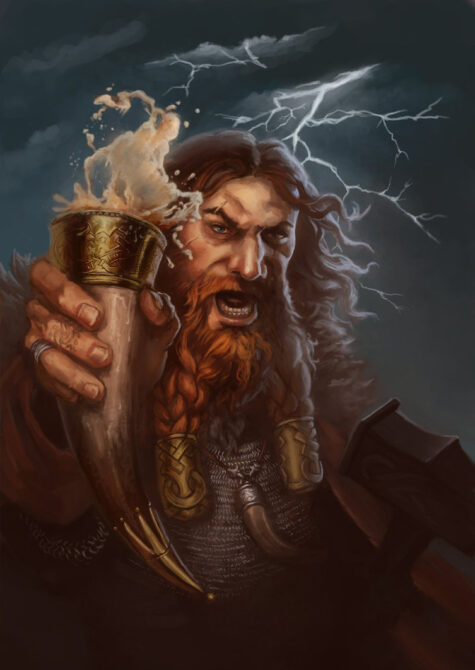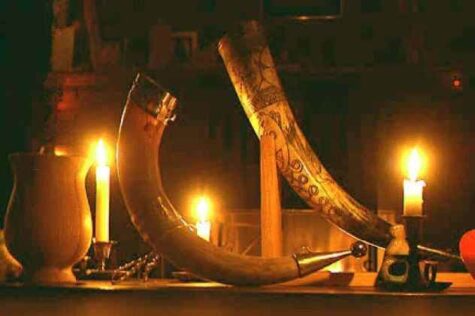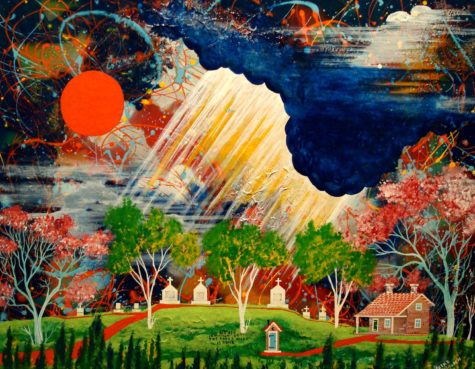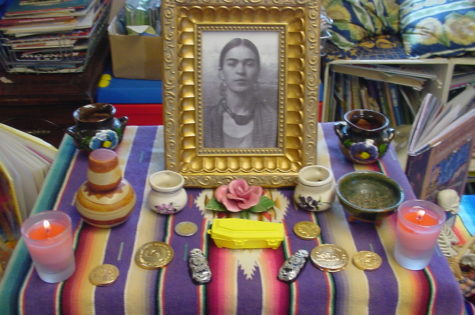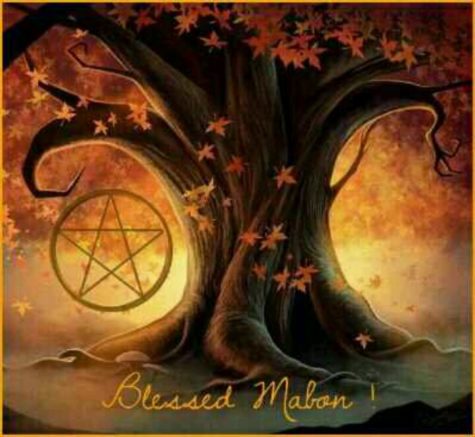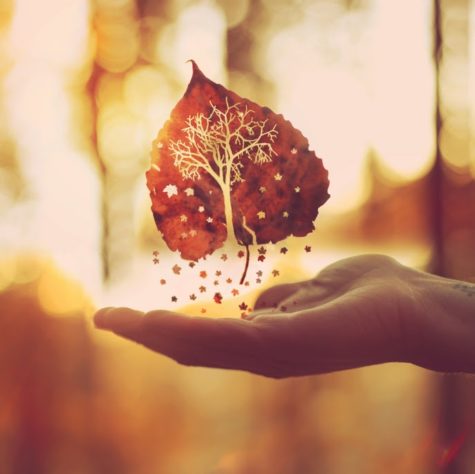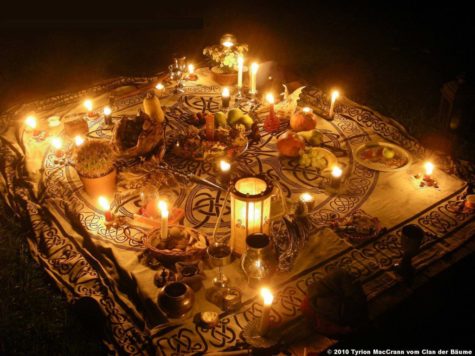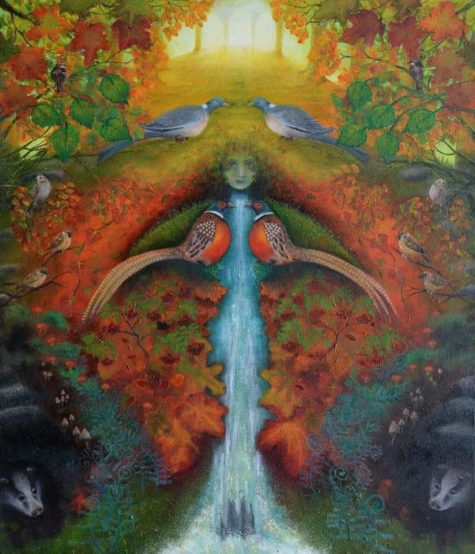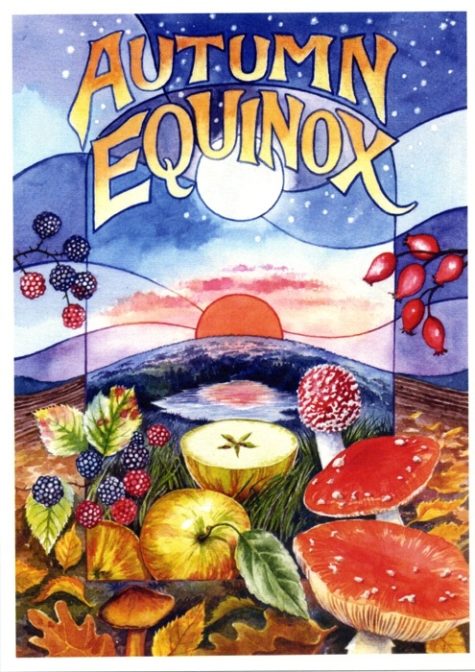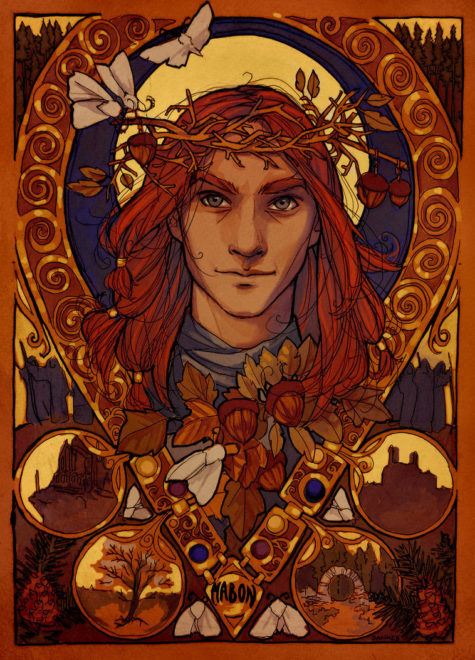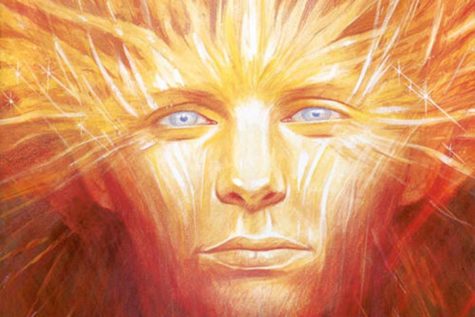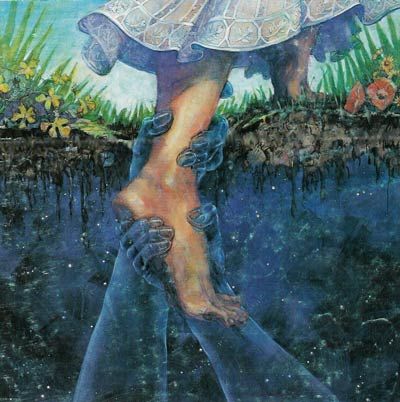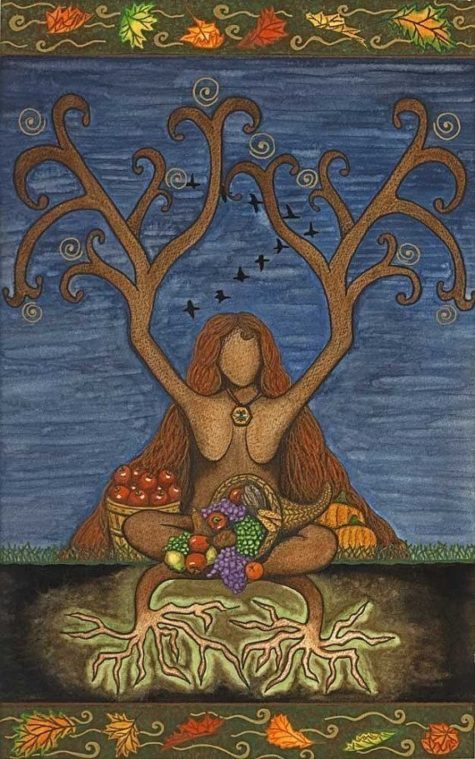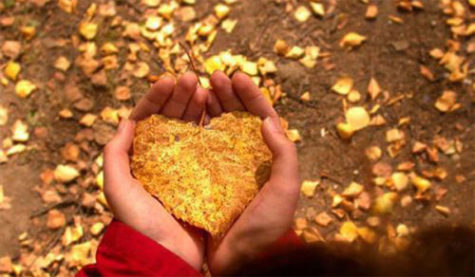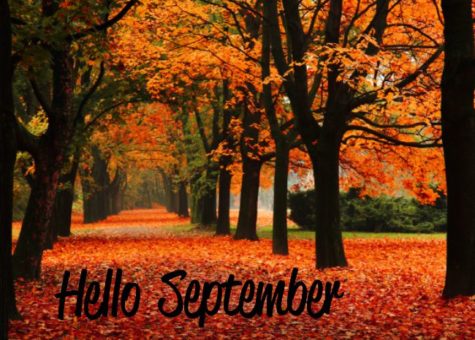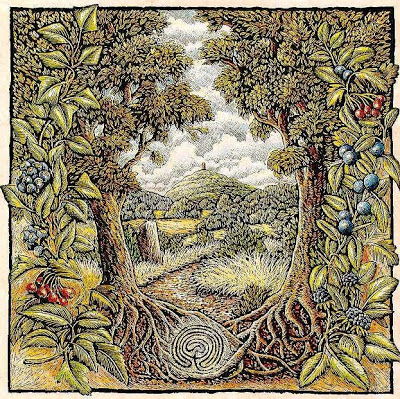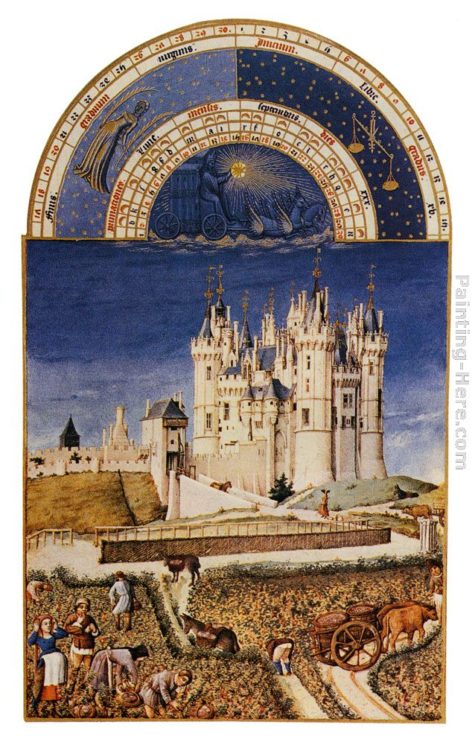Fall Festivals
In the Old Icelandic Calendar, winter begins on the Satyrday between Hunting 11th and 17th. This festival marks the beginning of winter, which was often celebrated around the middle of October. Winter Nights celebrates the bounty of the harvest
- Also referred to as: Vetrablot, Vetrnætr, Winterfylleth, Veturnætur, Winter Finding, and Winter Day.
Winter Nights is a more accurate term, considering that the passage of time was marked by nights, not days. An example of this can be seen from Anglo-Saxon times as it applies to the English word ‘fortnight’ as a reckoning of time for two weeks.
Just as traditional Jewish sabbat begins at sundown on Friday until sundown on Saturday… it appears that the festivities traditionally kicked off at night. This allows participants to work to prepare for the party during daylight hours too. On occasion you may even see reference to the term Winter Finding.
Some groups use this as being synonymous and interchangeable with the term Winter Nights. But others will call the harvest celebration at the autumnal equinox Winter Finding, and call the later October celebration Winter Nights instead.
Though we know the various names of the holiday, we don’t really know how people celebrated Winternights. Some people honored Freyr at this holiday, where He was given a sacrifice to thank him for the year’s harvest.
Some traditions honor Freya and the fertility and protective spirits called Disir, that She leads (often the Disir are seen as our female ancestors). Glory is given to Freya, a libation of ale, milk, or mead was poured into the soil as an offering to the Disir and the Earth itself.
We know that in Sweden, an event called an Alfarblot was held around the same time of year. It was a private event where ale was served and livestock were likely sacrificed. As Freyr is the lord of Alfheim, this event may be related to Winternights.
Some people honored Odin instead; some honored the dísir (female ancestors), some honored the alfar (elves; or male ancestors). Some people likely did a mix of all of the above.
When celebrating Winternights with a definite disir/alfar focus. Food is shared at a potluck based on recipes passed down to us from our ancestors or foods that they preferred. A sumbel is in their honor, honoring specifically those who have passed on in the last year, both animals and humans, and then sharing the stories of the food we brought, and of our ancestors of blood and of spirit. This can be an intimate, moving ritual, and a great way to start the winter season.
- A Sumbel is a formal drinking ritual composed of toasting, hails, oath-taking, the recitation of poetry or song, and other forms of verbal expression.
A Winternights sumbel might start with a round to Freyr to thank Him for the past harvest and to ask for prosperity in the days ahead. A round is included for the recently departed and for our ancestors of blood and of spirit as well.
So today we have a range of practice as it applies to this time of year. Some opt to celebrate it at the time of the autumnal equinox for sheer simplicity. But many others will instead decide to observe Winter Nights in October as that’s more in keeping with the traditional calendars.
Others split the celebration up, observing a Harvest-tide celebration in September, and then in October they will instead opt to specifically come together to honor the ancestors.
If you have children, incorporating ancestor veneration at this time helps to sync up to the Halloween and Day of the Dead décor that is on the market, and allow the children to have some similar dialogue among their peers at school. What Winternights does have in common with modern Samhain and Day of the Dead traditions, is that we both honor ancestors with their favorite foods and drink.
A Blot for Winternights
I hope all Heathens have a satisfying Winternights for both the living and the dead this year . Hail the disir! Hail the alfar! Hail Freyr!
- Hallowing:
Thunar, Guardian of Asgard and Midgard, We ask you to ward this stead well for Winternights. Hail Heimdall warder of Bifrost we ask that you hold us in your great sight.
- Purpose:
We gather to honor the Aesir and Vanir on this Winter Night and give thanks for the fruits of this past year and the Harvest we have gathered from the Earth. We also look back on the past year and measure our time that it was used wisely; to look at the future to find our way; like the Ice of time scrubbing away the impurities to leave behind the clear work.
We ask the dwellers of Asgard to give us the strength to and to help us provide for our kinsman in preparation for the long Winternachten yet to come.
- Hails:
Hail Wodan, The All Father, for your wisdom and forethought in guiding us forward through the winter to come and for the knowledge you have shared with us.
Hail Wodan!
Hail to Fro Ing for the bountiful harvest you have brought to us this eve.
Hail Fro Ing!
Hail to Freya for the love and life we hold to our hearts.
Hail Freya!
Hail to all the Ases and Wanes for the mighty work that you do.
Hail the Ases and Wanes!
And Hail to our Ancestors and Wights of the land. Hail to the All who have crossed Bifrost before.
Hail the Ancestors!
- Welcoming:
We welcome all the Ases and the Wanes. We welcome all the Wights, Alfs and Ancestors who have gone before us. We Welcome all the Wights and Landvaetter to witness this rite rightly done so that you shall see the truth in our hearts.
Heilsa all!
The time of Winternights marks the passing of Sunna farther down into the sky. This time of year marks the Mother Earth going to sleep to be rested for the coming Spring; for Fro Ing to renew the fertility of the Earth to bring forward the crops of our folk.
We look forward to Yule that is fast approaching. And we honor our ancestors that have gone before us. We look back over this past year with pride of the work rightly done. We look forward to prepare for the coming of winter, to protect our hearth and Kin from the cold of the frost giant called Winter, to open our hearths to those in need.
With this hallowed drink, brewed with the hand of Aegir the Brewer of Asgard we give our toasts:
- Wassail All!
Hail to the Aesir and Vanir!
Hail to the Alfs and the Dises!
Hail to our Ancestors!
Hail to the Landvaetter and all Wights of weal!
We now offer this sacrifice and return it to the Earth.
- Personal Hails!
Heilsa!
- The Blessing and Ending
We thank the Gods and Goddesses, the Aesir and Vanir for the gifts that we have and the gifts we may receive, May you find us fitting to receive them.
Heilsa All!
Sources:
- Asatru Utah
- Patheos
- Wyrd Designs
- Erich Shall
- Grundair Karlson
When we consider the month of October and Halloween, our modern take on the Holiday is largely fun and commercially driven, celebrated with spooky costumes and all our favorite Halloween treats. However, this time of year wasn’t always celebrated with ‘trick-or-treating’. Instead, many cultures focus on the celebrations honoring those that came before us.
As we head into the Halloween season, the veil that exists between our world and that of the spiritual will has started to thin out. On Halloween night, also known as All Hallows Eve, it is said that this veil drops, allowing those in the spiritual world to move freely among us. Now, this may sound concerning, to say the least, but don’t get too worried yet. Much like us here on in this life, the spiritual world is filled with both good and not so good spirits. While there are sure to be some mischievous beings trying to bring mischief and chaos into our lives, it is believed that we will also be visited by our deceased loved ones.
The concept of the dead moving among us is the underlying concept behind the Day of the Dead or Dia de los Muertos. Often known as a holiday celebrated in Mexico, records show that these traditions can be dated back as far as the Aztecs. Spanning two days, the holiday specifically focuses on honoring our deceased loved ones, through the use of parties, parades, feasts and other celebrations. Many who celebrate also done colorful costumes and skull makeup, also known as sugar skulls, a symbol that has come to be highly recognizable in today’s pop culture.
All Saints’ Day and All Souls’ Day are also similar to Day of the Dead. These are celebrations embraced by Western Christianity, in which the souls of faithful Christians who have paced are honored with the placing of flowers or candles at their grave sites, and church services discussing their memory. During this time, Christians also pay tribute to the martyrs and saints.
Also known as ‘Summers End’, Samhain is the Pagan holiday celebrated at this time. While this holiday is largely associated with the celebrations of the ancient Celts, many Pagans, Wiccans and Druids will celebrate Samhain around the globe. The holiday marks the end of the harvest season and beginning of winter, however, it also includes a number of celebrations including bonfires and feasts, honoring those that came before them.
Are You Looking For Ways To Honor Your Deceased Loved Ones During This Time? Here Are A Few Ideas:
- Cook a specific meal in honor of your deceased loved one. This is a regular part of the celebrations of Day of the Dead. Those who celebrate would cook the favorite meal of their loved one to ‘share’ in celebration of their time together.
- Use meditation to allow you to open your mind and your heart to communication from your loved ones. Remember, they are moving among you and may very well be trying to let you know that they are there.
- If you do still visit the grave site of a loved one, take some time out this night to be there. Place a lit candle, a flower of your choice or some other memento to show you were there. If you feel their presence, speak aloud to them. Remember, they are moving among us.
- Light a black candle, paying tribute to the stages of life and the inevitable darkness that comes with its final stage, death. Candles are also often used as a tribute or memorial to those who have come before us. If you wish, you can carve the name of your loved one into a taper candle and burn it in honor of a specific loved one.
- Gather friends and family together and light a large bonfire. Share your favorite stories of your friends and loved ones as you feel them moving among you. You can also include their favorite food and drinks in the evening’s celebrations.
- Choose to celebrate life by giving thanks for the life you were given, and that of the family members that came before you. Make a list of all the reasons you have to be appreciative at this time.
- Set up an altar to honor the specific loved ones that hold a special place in your heart. This may include photos or objects that hold a special meaning of some form.
- Take part in an activity that meant something to a friend or loved one that you are choosing to honor. For example, if you recently lost your brother and he was highly into superhero movies, you could enjoy a movie marathon night either on your own or with other loved ones who knew him.
Source: Awareness Act
Mabon (pronounced MAY-bun, MAY-bone, MAH-boon, or MAH-bawn) marks the Second Harvest, the end of the grain harvest (which begun at Lughnasadh), and rests on the Autumn Equinox. The Equinox mirrors dwindling of life (and eventual progression to rebirth), as well as the struggle for balance; day and night are equal for a single day.
- Celebrated with wine, apples, garlands, gourds and cornucopias.
- With decorations of orange, russet and maroon.
- Honoring the aging Gods and Harvest deities.
Various other names for this Lesser Wiccan Sabbat are The Second Harvest Festival, Wine Harvest, Feast of Avalon, Equinozio di Autunno (Strega), Alben Elfed (Caledonii), or Cornucopia.
Mabon is a celebration of life and death, and giving of life again, the cycle of the seasons. Mabon is a time to enjoy the fruits of a hard year’s labor, to stock up for the long winter. No matter how you celebrate Mabon, or how it came about, or whatever it’s true name may be, it is important to know that Mabon a time for giving thanks.
At the Autumn Equinox we all take a moment to pay our respects to the impending dark. We also give thanks to the waning sunlight, as we store our harvest of this year’s crops.
During this festival it is appropriate to wear all of your finery and dine and celebrate in a lavish setting. It is the drawing to and of family as we prepare for the winding down of the year at Samhain. It is a time to finish old business as we ready for a period of rest, relaxation, and reflection.
The pagans of antiquity didn’t have the ability to determine astrological positions as we do today. The European peasantry, therefore, celebrated this Sabbat on September 25th; actually, the Celts marked their days from sundown to sundown, so the Mabon celebration actually started on the sundown of our September 24th. Today, with the help of our technology, we can calculate the exact day of the Equinox; the date when the sun enters the sign of Libra, the Balanced Scales, which appropriately fits the Equinox.
The Druids call this celebration, Mea’n Fo’mhair, and honor the The Green Man, the God of the Forest, by offering libations to trees. Offerings of ciders, wines, herbs and fertilizer are appropriate at this time. Wiccans celebrate the aging Goddess as she passes from Mother to Crone, and her consort the God as he prepares for death and re-birth.
The Teutonic name, Winter Finding, spans a period of time from the Sabbat to Oct. 15th, Winter’s Night, which is the Norse New Year.
As a holiday, Mabon represents the time of honoring the dead, visiting burial sites, giving thankfulness for the end of the harvest season and the bounty it provides. These are the themes of closing, letting go and remembering. For the year, the harvest and for those who were lost to land of Avalon during the year.
Decorations and Activities for Mabon
Activities vary with region and tradition, as well as personal preference. Some ideas include making a Sun Wheel or wreath. Also, one could mirror the Celtic tradition of dressing a corn stalk in cloths and burning it in celebration of the harvest and upcoming rebirth.
Simple altar decorations can be obtained by taking a calm “pilgrimage” through your local woods and collecting leaves, acorns, berries, and other things symbolic of nature’s bounty. Some chose to sprinkle Autumn leaves around the house and on the sides of walk ways as decoration, though this may not be convenient if one lives in the city or doesn’t enjoy the cleanup. Alternately, the changing leaves can be dipped in paraffin and put on wax paper. After the leaves dry, they may be placed around the house or in large jars with sigils of protection and/or abundance carved lightly into them.
Additional seeds and grains can be set out as offering to our fellow creatures, and provide a healthy chance for birds to join in the celebrations as well. Symbolic designs can be made out of the sprinklings if one chooses. Those less fortunate should not be omitted from the celebration. Small, meaningless (to you) packages of food and drink gifted to a homeless person will make their day!
To honor the dead, it is traditional to place apples on burial cairns as symbolism of rebirth and gratitude. This represents the promise of the Great Spirits for renewed life (a new incarnation). Furthermore, it is a time to honor the elders, who have devoted so much time and energy to your growth and development. Something special is in order for these gracious people.
Going through your personal gardens with thanks and lovingly harvesting what is ready is also appropriate. Breads may be baked in the shape of the Sun, combining fruits or vegetables and grains, incorporating both of the major aspects of this Harvest. The seeds of various plants are stored through winter for replanting, and therefore, the plant’s rebirth in the Spring. A feast for friends and family always provides a cheerful abundance of energy and thanks.
Although many view the Harvest season as a celebration of life, it is also a celebration of death. The bounty you gather from your garden provides nourishment for you, family and friends. But it is also the death of those plants and vegetables which have been harvested from that garden. Thus Mabon is a celebration of the cycle of life.
This is a Celtic festival of thanksgiving, so what a better way to give thanks than to prepare a meal with the harvest of your garden. Those that indulge in wine can brew a new batch of this home made nectar of the Gods. Those that do not indulge, can brew preserves and jellies from grapes, raspberries and blackberries. Don’t forget an apple pie for dessert.
A main course can consist of meats, most often red meats. But this is just a suggestion. In this day and age of healthy eating, you should prepare a meal that fits your personal lifestyle. However, your side dishes should consist of late summer and early fall vegetables.
During your meal, share tales and happy stories about those you lost during the year. Or share your experiences and review the lessons you feel you have learned during this past season. Reflect on your deeds and actions and give thanks for the gifts you were given.
After your meal, share the chore of cleaning up. This is a way of showing honor and respect to your host and hostess. Think of it as a physical action to show that you understand the interconnection of all life and the desire to respect what you have been given and thanks for receiving those gifts.
During the evening hours you can continue the festival with a formal holiday ritual. There are as many ways and suggestions for conducting such a ceremony as there are people on this planet.
End your evening in private reflection. It is important for anyone practicing a spiritual life to reflect on his or her actions. Record your thoughts, your emotions and your experiences. This is the true value of your book of shadows. And there is no better time to take stock of yourself and your life than during a High Holy Day.
Ritual For Mabon
This Ritual is best performed during the early evening hours, just after Sunset, as this is the time of day which corresponds to the time of year. Sweep area, starting in the North and moving deosil (clockwise or sunwise direction), with your magickal broom to cleanse the Circle area and “sweep away” any lingering negative energies. Lay out the circumference of your Circle with cord, stones, etc., as necessary.
Set up the Quarter candles (North-Green, East-Yellow, South-Red, West-Blue) and/or other items symbolizing the elements at the Four Quarters (use a compass if not permanently marked out). Set up your altar as desired, and face it to the North, covering it with the red altar cloth.
Place all of the items listed below in their proper places upon it. For this ceremony, decorate the altar with the cornucopia filled with harvest items, and whatever else feels right. In addition to your usual tools and props, upon the altar should be:
- Red or Brown Altar Cloth
- Cornucopia filled with Fruits and Vegetables of the Harvest
- A Red Apple
- Bolline or another Sharp Knife (for cutting the Apple)
- Altar Pentacle or a Plate (to cut the apple on)
- A Bell
- A Second Wand decorated with Colored Ribbons (to use in the Demeter/Persephone portion of the ritual)
- A Wicker Basket (to carry the Decorated Wand in)
- Incense – Any of the following either alone or mixed together to make an Autumn Blend: Frankincense, Aloes Wood, Jasmine, Cinnamon, Musk, Cloves, Benzoin, Myrrh, and Sage
When all is set up, take a shower or bath for purification and don your ritual robe or other ritual attire. Be sure to wear your magickal jewelry. Sit quietly and meditate for a little while – to ground and center before beginning the Ritual. When you feel ready to begin, play some quiet peaceful music for the ritual.
Cast a circle in whatever way is familiar to you. After the Circle is cast, begin the Mabon sabbath Ceremony by sitting quietly for a few moments, then say these words aloud in dedication:
“Lady Autumn, Queen of the Harvest,
I have seen You in the setting Sun,
with Your long auburn tresses
blowing in the cool air that surrounds You.
Your crown of golden leaves is jeweled
with amber, amethyst, and rubies.
Your long, flowing purple robe
stretches across the horizon.
In Your hands You hold the ripened fruits.
At Your feet the squirrels gather acorns.
Black crows perch on Your outstretched arms.
All around You the leaves are falling.
You sit upon Your throne and watch the dying fires
of the setting Sun shine forth its final colors in the sky.
The purple and orange lingers and glows
like burning embers.
Then all colors fade into the twilight.
Lady Autumn, You are here at last.
I thank You for Your rewards.
I have worked hard for these gifts.
Lady Autumn, now grant me peace and rest.”
Sit quietly again and reflect on the meaning of the Autumn Season for a little while.
When you are ready, pick up your wand and hold it in your power hand, face the North and with your arms outstretched (kneel or stand) and say:
“The Wheel of the Year turns on and on,
bringing us all to and from each Season,
and from and to another.
What will be is. What was will be.
All time is here and now in this Sacred Space.
I now pause to watch the Wheel turn
and cast this Circle on this blessed eve
to celebrate the Season of Mabon, the Autumnal Equinox –
the time of the Second Harvest.
In this moment between time,
I come to praise the bountiful aging Goddess
and Her consort, the God of the Harvest.
I wish to give thanks and feel myself
as a part of the relentlessly turning
wheel of life, death, and rebirth.
O Great God of Wine and the Harvest,
who has been known as Mabon, Dionysus, Bacchus, and Thor –
Grant me strength and understanding
throughout this season and always.
O Great Goddess of the Harvest and the Underworld,
who has been known as Demeter, Persephone, Modron, and Morgan –
Teach me the secrets of the Mysteries and the ways of magic.”
Place your wand back in its place on the altar.
Spread your hands out over the Harvest Altar and say these words:
“The time of change is upon us again –
the Equinox comes, the Wheel turns…
The Goddess and the God prepare for
Their journey to the Otherworld,
as the Earth and all of Her children
prepare for the time of quiet and
reflection that lies ahead…
May I use this Autumnal period to
seek for the strength and power within
to assist me on my own quest for
vision, feeling, and peace…
May I see and feel the presence of
the Goddess and the God within,
though without,
the Earth begins Her slumber…
Keep me in Your light…”
Lower your arms and sit quietly meditating again for a while.
When you are ready, stand at your altar facing the North and raise your arms in greeting. Say:
“Between the worlds I build this sacred altar.
Outside of time, this rite leads to the ancient way.
Where I may find Demeter of high Olympus
And conjure magic great. Be here, I say.”
Place the decorated wand in the wicker basket and carry it to the North. Say:
“Persephone returns to the Underworld.
Weep not, Earth Mother,
For the Divine Child of love is here.”
Carry the basket to the East; say:
“Persephone returns to the Underworld.
Although the Light is fading,
It shall return to the Earth.”
Take the basket to the South; say:
“Persephone returns to the Underworld.
The cold of winter comes,
But only for a short time.”
Finish by carrying the basket to the West; say:
“Persephone returns to the Underworld.
The Earth shall lie in slumber
Until the Light of this Divine Child
Once more grows in strength and shines full upon us.”
Place the basket on the floor before the altar. Ring the bell three times.
Take your bolline in your power hand and the apple in the other. Say:
“Reveal to me your hidden secrets
That I may come to understand your sacred Mysteries.”
Set the apple on the altar pentacle (or plate) and cut it crosswise (with the bolline) to reveal the pentagram in the core. Contemplate this hidden sacred symbol for several moments. Then say:
“In life is death, in death life.
All must follow the sacred dance into the cauldron,
Time after time, to die and be reborn.
Help me to remember that
Every beginning has an ending
And that every ending has a new beginning.”
Take a bite of the apple.
What is left put outside later to share with the birds.
Say:
“Holy Mother, Demeter,
Comfort and protect me in my times of tribulation.
Instruct me into the Mysteries.
You, with your daughter Persephone, have the power
To lead me to new understanding.”
Now is the time for meditation and any spellworkings you may need or desire to end your sabbath celebration. Appropriate Spellwork for Mabon include those for protection, wealth and prosperity, security and spells to bring a feeling of self-confidence. If no spellwork is to be done at this time, then proceed with the Cakes and Ale Ceremony – or whatever is your practice, followed by Releasing the Magic Circle.
Please note this ritual is based on the Northern Hemisphere correspondences of elements and their colors, and directions and so on.
Mabon History
Mabon (May-bawn) is also known as the Feast of Avalon and the festival of the Wine Harvest. To the Celts, Avalon is the mysterious place for the land of the dead. and literally means the “land of apples”. Thus this is a holiday for celebrating the bounty of the harvest and the desire for the living to be reunited with their deceased loved ones.
But the holiday is also named for the Welsh God Mabon. Mabon means the “great son”. He was the son of Modred, kidnapped at the age of 3 and later rescued by King Arthur. His life represents the innocence of youth, the strength of survival and the growing wisdom of the elderly. Perhaps it is this view of the cycle of life that brings Mabon to his most popular role, the King of the Otherworld and the God of Darkness.
His myths overlap with other Gods such as the Welsh God Gwyn Ap Nuad, which means “white son of darkness”. He is seen as the God of war and death, the patron God of fallen warriors. Once again this is a representation or connection to the Land of Avalon.
Sources:
Autumn Equinox refers to a time of the year when day and night are equally balanced. The dates vary slightly, falling between Sept 21 and Sept 23. The sun is in the process of crossing the equator and in astrological terms is entering the sign of Libra.
The sun is the focal point of energy (along with the moon) and such; its life force pushes us to discover more about ourselves. This movement into the Libra puts a congenial, cooperative outlook on that time of year, just what was needed by the communities, as they all worked together to complete the harvest.
Other names for the Autumnal Equinox include:
- Alban Elfed
- Cornucopia
- Equinozio di Autunno
- Fall Equinox
- Feast of Avalon
- Festival of Dionysus
- Festival of Strong Will
- Harvest Home
- Second Harvest Festival
- Wine Harvest
- Winter Finding
Harvest Home is an Anglo-Celtic version of the original Mabon, and fell in-between the First (Lugnasadh) and the Third (Samhain) Harvests. Harvests festivals were a very important part of the pre- industrialized culture. It was a time of relief and of rest. Relief that the crops were in and rest to catch their breath before the work of preparing for winter began. This was a time to give thanks.
- Color of the day: Yellow
- Incense of the day: Coriander
Once again the Sun’s path crosses the celestial equator, and the day and the night are now again of equal length. On the Gregorian calendar this is the first day of autumn, but on the modern Celtic calendar it is midautumn.
Autumn Equinox in Welsh Mythology
This holiday is more commonly known by its Welsh name Mabon. Mabon means “divine youth.” It is the name of a mythic hunter hero whose story is told at this time of year. At the beginning of time, Mabon was born to the mother goddess Modron. That we only know his mother and not his father attests to the matriarchal lineage of the early Celts.
The equinox marks the time when Mabon was three nights old and stolen from his crib. For the next three months, the heroes Cai and Bedwyr will search for him and ask all manner of birds and beasts for help. But, according to legend, it is only the salmon who can give them direction. On Yule, the heroes retrieve the divine child by freeing him from a prison in Gloucester.
Like Apollo, Mabon is a hunter with a bow and a musician with a harp. He is a Sun god. Mabon represents the Sun that is waning in strength during this quarter of the year and that will begin to return only after the solstice. The waning of the light is frightening and depressing, and it is necessary for our own sake to use magic at this time to help in the quest for Mabon.
The strongest act of magic that one can do at this time is to participate in the celebrations of the yearly cycle. As one integrates the yearly cycle deep into one’s unconscious, serenity and confidence are gained. This is the peace that comes from knowing and accepting that the light will return when it is time.
Autumn Equinox in Celtic Mythology
In this variation of the legend of the Autumn Equinox, this is the day of the year when the god of light, Lugh, is defeated by the god of darkness, Lugh’s twin and alter-ego, Tanist. The night conquers day.
The tales state that the Equinox is the only day which Lugh is vulnerable and the possibility of his defeat exists. Lugh stands on the balance (Autumn Equinox-Libra) with one foot on the goat (Winter Solstice-Capricorn) and the other on the cauldron (Summer Solstice-Cancer). He is betrayed by Blodeuwedd, the Virgin (Virgo) and transformed into an Eagle (Scorpio).
Two events occur rapidly with Lugh’s defeat. Tanist, having beaten Lugh, now takes over Lugh’s place both as King of our world and lover to the Goddess Tailltiu. Although Tanist now sits on Lugh’s throne, his official induction does not take place for another six weeks at Samhain, the beginning of Winter, when he becomes the Dark King, the Winter Lord, the Lord of Misrule. He mates with Tailltiu, who conceives, and will give birth nine months later (at the Summer Solstice) to her son, another incarnation of Tanist himself, the Dark Child.
Lugh’s sacrifice represents not only the sun’s dying power, but also the cycle of rebirth, his energy remaining within the corn we have since harvested. A incarnate (of Lugh) corn spirit was thought to specifically reside within the last stalk (or stock), which was traditionally dressed in fine clothes and decorations, or woven into a wicker man-shaped form. This symbolic decoration was then harvested and carried from the field to be burned with rejoicing for the spirits release and Lugh’s upcoming rebirth.
The Autumn Equinox in Greek Mythology
In Greek mythology, Autumn begins as Persephone returns to the Underworld to live with Hades, her husband.
In short, the myth says that Demeter’s daughter, Kore, had taken a day to pick flowers in a meadow when the Earth opened up, and Hades pulled the girl into the Underworld to become his bride. Kore’s name became Persephone when she married Hades.
For nine straight days, Demeter searched for Kore, with no success. In misery and despiration, Demeter questioned Helios, the Sun God, who informed her that her brother, Zeus, had given the girl to Hades. Furious, Demeter left Olympus to roam the Earth disguised as an old woman, ending up settled in her temple at Eleusis.
Soon after, she cursed the Earth so it would yield no crops. Zues sent her a frantic message inquiring as to why she had prevented growth on the planet. She replied that there would be no regeneration of vegetation on the Earth until her daughter, Kore, was safely returned.
Zeus immediately dispatched Hermes into the Underworld to retrieve the girl. Hades, not wanting to relinquish his bride permanently, convinced Persephone to eat some pomegranate seeds before she returned to her mother, Demeter. Demeter was yet again distraught when she learned of this trickery! Finally, Zeus declared that Kore-Persephone would live with her mother during one half of the year and return to her husband, Hades, during the other half. In thanks, Demeter lifted the curse on the Earth, creating Spring. Every year hence, during her time of greatest sorrow, Demeter renews the curse, as her daughter returns to Hades and the Underworld.
Sources:
- Ravenna’s Wheel of the Year
- Widdershins
- Gordon Ireland
- Llewellyn’s Spell A Day
The Autumnal Equinox festival is known in some traditions as Cuivanya or the Feast of Divine Life. This particular version of this celebration of the Autumnal Equinox is a holy day in the Filanic tradition.
- What is Filanism?
Filianism (the “Daughter Tradition” – from filia,daughter) is a religion that is sometimes considered to have started, or taken its current specific form, in the 1970s, since that is when it first became publicly known. Its first recorded modern appearances were in Britain, although some have postulated a Greek or Asian origin for its Scriptures and philosophy.
It is one of the four Cardinal Feasts of the year, and stands at the center of both the Mysteries of Life Cycle and the Mother Half of the year. It falls on the 17th of Abolan the apple-month (21st September) – approximately at the autumnal equinox.
The element governing the Fall season is Earth, and the festival itself is often considered to be the Harvest Festival.
While the association of the Mother God with the element of earth (the Earth Mother) has its roots in patriarchal “demotion” of the divine feminine to the lesser elements – attempting to make Her earthly and lunar as opposed to Solar and Spiritual – it must be remembered that in the beginning, the Mother Goddess was rightly understood to rule all elements of creation. Thus the patriarchal error lies not in seeing the Goddess as Earth Mother, but in seeing her only as Earth Mother and not also as Sky Mother, Solar Mother, and Queen of Heaven.
The idea of a Harvest Festival is often seen as “primitive” people, dependent on agriculture, giving thanks for their material survival and for the harvest that will permit them to eat. They then (according to “scientific” thinking) invent “gods” as a sort of imaginary explanation of the physical realities of life.
In fact the reverse is true. Our ancestors lived far closer to the Spirit than we do. Everything they did was spiritual first and physical second. The transition to agriculture was fundamentally a spiritual phenomenon. It was a part of the increasing materialization of maid: her becoming more and more a creature living on the physical plane.
But this in itself was spiritual: part of the process of cosmic manifestation. The rituals of agriculture were rituals first and practicalities second. They represented a new spiritual orientation for earthly life which remains with us to this day.
The central symbol of the autumnal equinox Harvest Festival, is the scythe or sickle. This is a symbol that represents both life and death. It symbolizes the harvest and the abundance of the earth, the coming to fruition of all the good things that have been planted and tended, both materially and spiritually. At the same time it represents cutting-down and death. The death of the individual, and ultimately the death of the cosmos itself, when all creation is in-breathed back into Absolute Deity, the Dark Mother who out-breathed the cosmos in the beginning.
Indeed, the Feast of Divine Life, while it is devoted to the entire Trinity of Mother, Daughter, and Dark Mother may also be called the true Feast of the Dark Mother (and indeed the festival marks the beginning of the dark half of the year).
The Dark Mother, or Absolute Deity (nirguna brahman – God Beyond Form) is called “Dark” because we can know nothing of Her. As the Vedantins put it, we can only assert of Absolute Deity: neti, neti “not this, nor this”. Yet while She appears Dark to us, the Dark Mother is hailed as “Dark beyond the Light and Light beyond the Darkness”. At Her darkest (from the worldly point of view) she is the “grim” Reaper, reaping not only the human soul at the end of a single life, but the entire creation at the end of all worlds.
But reaping has a double significance. In one sense it is “death” but in another sense it is harvesting, the coming to fullness and consummation of life. And it is this fullness and richness of Divine Life that is the primary theme of the great festival of the autumnal equinox.
The Dark Mother is likened to “Earth” in its most metaphysical sense, as the Ground of All Being. As it says in the Scriptures: “Let her not trust the ground her feet are set on, and doubt the Ground upon which that ground stands.”
From the human, or worldly, perspective, the Dark Mother is the third person of the Trinity but from the spiritual perspective, She is the first, the very foundation of the Trinity itself. That is why the Festival of the Trinity is also the Festival of the Dark Mother, because, in focusing on the whole Trinity, and not just Mother/Daughter with the Dark Mother in the background, we have to see the Dark Mother as the “First Principle and the Final Cause” not only of the cosmos, but of the Trinity Itself.
The Dark Mother is the Ground from which all being proceeds, and the sickle that harvests it when its cycle is complete. She is “the Beginning and the End”. While the first feast of the Mysteries of life cycle, the golden Festival of Regeneration (Chelanya), celebrates renewed life, and the last, the Feast of the Dead (Tamala), celebrates death, the central autumnal equinox festival of Cuivanya celebrates life and death at once in the sacred mystery of the Harvest – the “death” that comes as the culmination and fulfillment of Life. The death to this world that is birth to a higher world.
And yet, of course, it is not death but life that is the primary focus of this autumnal equinox festival, and not simply life in the ordinary sense, but the fundamental connection of all life with the Divine, and as such, it is necessarily also the feast of the Holy Trinity, since the Divine Life that creates the universe is inherently threefold.
The Trinity of Our Mother God (sometimes called the “Triple Goddess”) is often compared to the Hindu Trimurti – Creatrix (Mother), Preserver (Daughter), and Destroyer (Dark Mother) of the worlds (or with their lesser reflection, the Three Fates, spinner, weaver, and cutter of the world-thread). But while it is true that the Dark Mother, or Absolute Deity, in-breathes all life and all being at the end of time, it is equally true that She out-breathes it at the dawn of time. She is both the first Sower and the final Reaper of all life and all creation. From Her proceeds the bright Solar Mother who creates the worlds, and from the Solar Mother proceeds the Lunar Daughter who maintains them in being for the whole of their existence.
Nothing exists outside the Divine, and all things are part of the Divine Life. While modern people tend to see much of the universe as “inanimate” or “lifeless”, our tradition teaches us that all things are infused with the Divine Life. The universe is ensouled – not in the same way that we are, but everything that is is infused with the Divine Intelligence. That is why, for example, the movements of the stars and planets are connected with the events of human life – not because one directly affects the other, but because both are part of what has traditionally been called the anima mundi, or world-soul, (but which, for the sake of disambiguation, we might prefer to term the cosmic soul).
Divine Life is present throughout the cosmos, not just in human, animal, or vegetative life, but in all creation, and this autumnal equinox festival traditionally expresses that through the agricultural symbolism of the harvest, which is not simply a “metaphor” but a ritual in the fullest and deepest sense of the world, reaching back into the times when all human activities were spiritual rites first and worldly activities only secondarily.
The very biological, chemical, cultural, and psychological factors that make agriculture both possible and necessary are bound up intimately with the living symbolism of the cosmos and our earthly microcosm thereof.
The truth is the exact reverse of the “modernist” or “evolutionist” notion that physical facts come first and metaphysical Truth is secondary. In reality, all things are spiritual first and physical only secondarily and reflectively.
Which is simply another way of saying that Our Mother God is the Ground of All Being, and that every aspect of the cosmic whole is simply an expression of the Divine Life that underlies it.
That is the fundamental Truth of the Feast of Divine Life, the great festival of the autumnal equinox. It is a celebration of the Divine that is present in all things and manifested to us in the wonderful golden abundance of the harvest, the yearly culmination of our dear Mother’s nurturing love for Her children.
Ideas for Celebrating the Feast of Divine Life
- Prepare a feast!
Traditional foods include apples, cider, and seed cake. Fruits and vegetables that have ripened at this time of year are also appropriate. Don’t forget to thank the Goddess for the food on your table and all the many blessings She has given you!
- Decorate your shrine
Decorate your shrine with the fruits of the season, especially apples, as they represent the golden apples of Avala! A brief summary of he symbolic significance of the apple and Avala is given below:
Avala is the Earthly Paradise, for although beyond this physical world, it is still below the level of pure Spirit as the resting place for spiritually awakened but still imperfect souls. The Tree of Life, at its centre, bears the golden apples of life eternal. The word “paradise” comes from a root-word meaning “orchard”. Avala and Elysium both mean “apple-land”. In many traditions, from the Sumerian and Greek to the Aztec, this paradise has been pictured as a mountain-top orchard which, in all earlier and most later accounts, belongs to a “goddess”. Thus the Sacred Mountain is Her mountain; the golden apples Her apples, for Hers is the gift of eternal life.
- Perform a Rite of Sacrifice
This can be an elaborate ritual, or a simple offering of food and wine. The basic prerequisite is that what is sacrificed to the Goddess must be something of value. It can also include a sacrifice of time and energy. For example: you could offer up Saturday mornings to volunteer to help feed the homeless, or time and energy to work in a community garden.
- Pray the Filianic Rosary
The purpose of these is to allow a Catholic-style rosary to be prayed by individuals and groups who worship the Mother God in Her Trinitarian form, as God the Mother, God the Daughter, and the “Dark” Mother who is Absolute Deity, beyond being and unbeing; as set out in The Filianic Creed.
Here’s a nice example of a Hail Mary:
Hail Mary, fount of Grace
Lady of earth and Heaven
Blessed art Thou by all maidens
And blessed is Thy most beloved daughter,
Holy Mary, Mother and God,
Shelter us fallen ones now and at the hour of hour death.
- Read passages from the Filianic Scriptures.
The scripture passage for the Feast of Divine Life is found in The Crystal Tablet, Verses 12-29, as given below from the Lux Madrian version:
12. Life is the life of the spirit-the first principle; beyond being and unbeing. Life was before existence. Life is the cause of existence.
13. How shall the soul live in Life?
14. Let her realise the truth of herself and the Truth of the Absolute. Let her know that her life is beyond even her existence, that the Absolute Life, the Life of the Goddess, is beyond all existence.
15. Let her not be held from herself or her Goddess by anything that exists, for all the things that are have come from nothing and to nothing shall return. But the Divine Life, and her life within it, Was ever and ever shall Be, though time itself shall only last a space.
16. Let her not trust the ground her feet are set upon and doubt the Ground upon which that ground stands. Rather, let her doubt the sea, the sky, the fingers of her hand, and the breath of her mouth; for all these things may be illusions, as in some sense they are.
17. But let her know Life Divine as the Truth beyond truth and the Faith beyond faith and doubt.
18. Life is pure force, or energy, or delight. It is the joy of the Goddess, and Her breath and Spirit.
19. Light is the outpouring of Life into existence. All things that exist come from Life; they are made and sustained by Light.
20. Though an existing thing appear never so solid, yet its body is made of light. All material things are but consolidated force; and the vibration of force is the whole of their being.
21. Yet material things are far from the Source of Light. They have become subject to consolidation and restriction.
22. Pure light knows no bounds, but is perfect joy, and breathes its own perfection.
23. How shall the soul approach to Light?
24. Let her make her every act a resplendent creation, and let every outpouring of her energy be a well-made gift for her Lady. Let her not fall into dullness, but be ever creating herself anew in the delight of her energy.
25. Let her not seek for reward, but only for her own perfection; thus shall the action itself become perfect. Let her turn from the transient and find delight in the Eternal.
26. For every earthly action is the shadow of some higher form; and the soul must choose whether in her act she shall approach that form, or sink from it into deeper shadows and the morass of illusion.
27. She who rejects the light of the Spirit in this world shall, beyond death, be plunged into darkness and the confusion of bodiless echoes.
28. But every act that is performed in dedication to the Mother is an expression of the soul’s true self, and loosens the chains of her bondage.
29. If the soul live in Light, no thing shall be impossible to her, for her will shall become one with the will of our Lady.
Sources:
September gets its name from the Latin word septum, meaning “seven,” because it was originally the seventh month in the old calendar system. The Anglo-Saxons called it Gerst monath (Barley month), because it was their time to harvest barley to be made into their favorite drink – barley brew. They also called it Haefest monath or Harvest month.
While the early portion of this month has many summery-feeling festivals, slowly we see a change in focus toward the fall and harvest celebrations. Children return to school, outdoor activities start to wane, and the Wheel of Time begins to paint the trees with color.
September’s energy augments magic for prosperity and abundance, balanced with sensibility and a little frugality. It is especially a time for rituals that thank the goddess for all her gifts throughout the year. Beyond this, start making amulets for health so that when the cooler winds come, you’ll be magically fortified.
According to the lore, September is a great month in which to marry:
- Marry in September’s shrine, your living will be rich and fine.
- Married in September’s golden glow, Smooth and serene your life will go.
- A September bride will be discreet, affable, And much liked.
September Correspondences
- Nature Spirits: Trooping faeries
- Herbs: Copal, Fennel, Rye, Wheat, Valerian, Skullcap
- Colors: Brown, Yellow-Green, Yellow
- Flowers: Narcissus, Lily, Aster
- Scents: Storax, Mastic, Gardenia, Bergamot
- Gem: Sapphire
- Stones: Peridot, Olivine, Chrysolite, Citrine
- Trees: Hazel, Larch, Bay
- Animals: Snake, Jackal
- Birds: Ibis, Sparrow
- Deities: Demeter, Ceres, Isis, Nephthys, Freyja, Ch’ang-O, Thoth
- Full Moon: Harvest Moon
- Autumn Equinox: Nature comes into balance
Power flow:
Rest after labor; Balance of Light and Dark. Organize. Clean and straighten up physical, mental, emotional, and spiritual clutter.
September Weather Lore
- Fair on September 1st, fair for the month.
- Heavy September rains bring drought.
- If on September 19th there is a storm from the south, a mild winter may be expected.
- If St. Michael’s (Sept 29) brings many acorns, Christmas will cover the fields with snow.
September Festivities
The Autumn Equinox was and is celebrated still by many cultures around the world. This month is the last of the reliable harvesting months in the Northern Hemisphere. Life is beginning to wind down in preparation for the dormant months that follow. The energy flows from the Autumn Equinox through Winter Solstice to the Spring Equinox are gentler, deeper, more hidden. The Dark Moon deities, who represent the Underworld, death, reincarnation, and deep spiritual mysteries, now hold sway.
The Egyptian Ceremony of Lighting the Fire was a general festival of lights for all the gods and goddesses. Lamps of all kinds were set in front of deity statues. They were also placed before the statues of ancestors.
The Egyptian deity Thoth was the Lord of Holy Words and inventor of the Four Laws of Magick. Portrayed as ibis-headed, Thoth was a Moon god. As Supreme Magus, or the Ultimate Magician, he had control over the powers and attributes of the Moon.
In the old Incan Empire, the Citua was held on the New Moon nearest the Autumn Equinox. Everyone performed a ritual cleansing, then smeared their faces with a paste of ground maize. There followed several days of feasting and dancing. This was a moon festival in honor of Mama Quilla, the Moon goddess.
Gauri, or the Fair One, is not a well known goddess of India. She is considered to be an aspect of the goddess Durga. Gauri is honored by eating sweets made from honey to bring sweetness to the soul.
The most famous holy celebration of this time of year was the annual Greek festival called the Greater Eleusinia. It honored Demeter, Kore-Persephone, and the holy child Iacchus. Unlike the Lesser Eleusinia held in the Spring, this celebration was open only to initiates who were under strict rule of silence about what occured.
The Greek goddess Themis was the Titaness daughter of Uranus and Gaea. She was the mother of Atlas and Prometheus and the mother by Zeus of the Horae and the Moerae (Furies). Since she was the deity of social order and collective consciousness, the Olympians held her in high respect. Holding a pair of scales, Themis protected the innocent and punished the guilty. She ruled Delphi after her mother Gaea, but relinquished it to Phoebe who gave it to Apollo.
The annual festival of Yue-ping was held in China from the New Moon to the Full Moon. People made round cakes and painted figures of women or a hare and trees on them. These were called Yue-ping, or “Moon cakes.” These cakes were presented to relatives and friends.
The Chinese said that the Moon Mother had twenty-eight “houses) (Hsiu) and rested each night in a different one. In each “house” she kept a warrior-hero consort who kept her company and did her bidding.
Sources: 365 Goddess and Moon Magic


